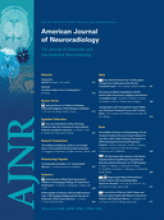Research ArticleBrain
Correlation between CT and Diffusion-Weighted Imaging of Acute Cerebral Ischemia in a Rat Model
H.S. Seo, D.G. Na, J.-h. Kim, K.W. Kim and K.-R. Son
American Journal of Neuroradiology April 2011, 32 (4) 728-733; DOI: https://doi.org/10.3174/ajnr.A2362
H.S. Seo
D.G. Na
J.-h. Kim
K.W. Kim

References
- 1.↵
- von Kummer R,
- Bourquain H,
- Bastianello S,
- et al
- 2.↵
- Grond M,
- von Kummer R,
- Sobesky J,
- et al
- 3.↵
- Schuier FJ,
- Hossmann KA
- 4.↵
- Todd N,
- Picozzi P,
- Crockard A,
- et al
- 5.↵
- Gotoh O,
- Asano T,
- Koide T,
- et al
- 6.↵
- Dzialowski I,
- Weber J,
- Doerfler A,
- et al
- 7.↵
- von Kummer R,
- Allen K,
- Holle R,
- et al
- 8.↵
- Barber P,
- Demchuk A,
- Zhang J,
- et al
- 9.↵
- Tanne D,
- Kasner S,
- Demchuk A,
- et al
- 10.↵
- Gonzalez RG,
- Schaefer PW,
- Buonanno FS,
- et al
- 11.↵
- Mohr JP,
- Biller J,
- Hilal SK,
- et al
- 12.↵
- Kohno K,
- Hoehn-Berlage M,
- Mies G,
- et al
- 13.↵
- Lin W,
- Lee JM,
- Lee YZ,
- et al
- 14.↵
- Kidwell CS,
- Saver JL,
- Mattiello J,
- et al
- 15.↵
- Neumann-Haefelin T,
- Kastrup A,
- de Crespigny A,
- et al
- 16.↵
- Li F,
- Liu KF,
- Silva MD,
- et al
- 17.↵
- Olah L,
- Wecker S,
- Hoehn M
- 18.↵
- Fiehler J,
- Foth M,
- Kucinski T,
- et al
- 19.↵
- Kim EY,
- Ryoo JW,
- Roh HG,
- et al
- 20.↵
- Davis D,
- Ulatowski J,
- Eleff S,
- et al
- 21.↵
- Hoehen-Berlage M,
- Eis M,
- Back T,
- et al
- 22.↵
- Pierapaoli C,
- Righini A,
- Linfante I,
- et al
- 23.↵
- Gerriets T,
- Stolz E,
- Walberer M,
- et al
- 24.↵
- Kastrup A,
- Engelhorn T,
- Beaulieu C,
- et al
- 25.↵
- Lutsep H,
- Albers G,
- de Crespigny A,
- et al
- 26.↵
- Schlaug G,
- Siewert B,
- Benfield BS,
- et al
- 27.↵
- Kucinski T,
- Vaterlein O,
- Glauche V,
- et al
- 28.↵
- Longa EZ,
- Weinstein PR,
- Carlson S,
- et al
- 29.↵
- Torack RM,
- Alcala H,
- Gado M,
- et al
- 30.↵
- Rieth KG,
- Fujiwara K,
- Di Chiro G,
- et al
- 31.↵
- Unger E,
- Littlefield J,
- Gado M
- 32.↵
- Watanabe O,
- West CR,
- Bremer A
- 33.↵
- Menzies SA,
- Betz AL,
- Hoff JT
- 34.↵
- Go KG
- 35.↵
- Sevick RJ,
- Kanda F,
- Mintorovitch J,
- et al
- 36.↵
- Moseley ME,
- Cohen Y,
- Mintorovitch J,
- et al
- 37.↵
- Wick M,
- Nagatomo Y,
- Prielmeier F,
- et al
- 38.↵
- van der Toorn A,
- Dijkhuizen RM,
- Tulleken CA,
- et al
- 39.↵
- Duong TQ,
- Ackerman JJ,
- Ying HS,
- et al
- 40.↵
- Mintorovitch J,
- Yang GY,
- Shimuzu H,
- et al
- 41.↵
- Benveniste H,
- Hedlund LW,
- Johnson GA
- 42.↵
- Morikawa E,
- Gingsberg MD,
- Dietrich WD,
- et al
- 43.↵
- Le Bihan D,
- Delannoy J,
- Levin RL
- 44.↵
- Szafer A,
- Zhong J,
- Gore JC
- 45.↵
- Kuroiwa T,
- Nagaoka T,
- Ueki M,
- et al
- 46.↵
- 47.↵
- Kato H,
- Kogure K,
- Ohtomo H,
- et al
- 48.↵
- Boisvert DP,
- Handa Y,
- Allen PS
- 49.↵
- Qiao M,
- Malisza KL,
- Del Bigio MR,
- et al
- 50.↵
- Naruse S,
- Horikawa Y,
- Tanaka C,
- et al
- 51.↵
- Cvoro V,
- Marshall I,
- Armitage PA,
- et al
- 52.↵
- 53.↵
- Loh PS,
- Butcher KS,
- Parsons MW,
- et al
- 54.↵
- Nicoli F,
- Lefur Y,
- Denis B,
- et al
- 55.↵
- Guadagno JV,
- Warburton EA,
- Aigbirhio FI,
- et al
In this issue
Advertisement
H.S. Seo, D.G. Na, J.-h. Kim, K.W. Kim, K.-R. Son
Correlation between CT and Diffusion-Weighted Imaging of Acute Cerebral Ischemia in a Rat Model
American Journal of Neuroradiology Apr 2011, 32 (4) 728-733; DOI: 10.3174/ajnr.A2362
0 Responses
Jump to section
Related Articles
- No related articles found.
Cited By...
- No citing articles found.
This article has not yet been cited by articles in journals that are participating in Crossref Cited-by Linking.
More in this TOC Section
Similar Articles
Advertisement











